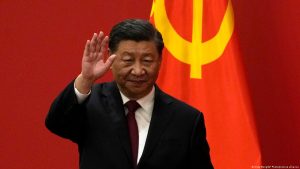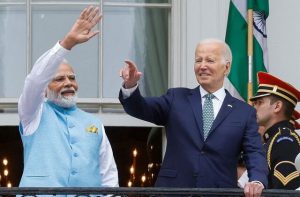 By Nageshwar Patnaik in Bhubaneswar, June 26, 2023: The United States of America needs India more than the latter needs the most advanced country in the world. This is the impression one gets in the aftermath of the historic meeting between President Joseph R. Biden, Jr. and Prime Minister Narendra Modi on Thursday.
By Nageshwar Patnaik in Bhubaneswar, June 26, 2023: The United States of America needs India more than the latter needs the most advanced country in the world. This is the impression one gets in the aftermath of the historic meeting between President Joseph R. Biden, Jr. and Prime Minister Narendra Modi on Thursday.
Undoubtedly, the meeting has heralded a new moment in bilateral relations and is a defining one for the evolution of Asian geopolitics, otherwise dominated by China in recent years. Both the leaders affirmed a vision of the United States and India as among the closest partners in the world – a partnership of democracies looking into the 21st century with hope, ambition, and confidence.
In a world fraught with geopolitical instability, both Modi and Biden have set a long-term agenda to draw their countries closer. But it is Washington which needs New Delhi firmly in its embrace. Modi’s State visit to the US highlights the trajectory of India-US relations which has witnessed a significant shift, marked by a promising partnership built on mutual respect and shared objectives.
For many decades since its independence in 1947, India has largely pursued a foreign policy of non-alignment, propounded by its first prime minister, Jawaharlal Nehru, in 1954. It underlined India’s commitment to an independent foreign policy seeking to avoid entanglements with any power bloc. During the Cold War, India initiated the Non-Aligned Movement and saw itself as the leader of developing countries. Many southern countries participated in the movement while the United States aligned with Pakistan and China against the Soviet Union. The two countries also had differences over issues such as nuclear proliferation, human rights, and regional conflicts.
It is true that there were attempts in the past to reconcile the India-US differences over Asia. The divergence included the assessment of Soviet Russia and Communist China, Washington’s Cold War alliances, and the US tilt to Pakistan in India’s war to liberate Bangladesh in 1971. Later the twin crises of Doklam (2017) and Galwan (2020) also convinced India to focus on the urgency of boosting its deterrence against China as the principal strategic objective.
 This inevitably led Delhi to seek stronger strategic partnerships with the US and its allies. This apart, the assertive policies of Chinese President Xi Jinping have literally ensured India and the US becoming closer than ever before notwithstanding the fact that China was keen in keeping India and the US apart in Asia.
This inevitably led Delhi to seek stronger strategic partnerships with the US and its allies. This apart, the assertive policies of Chinese President Xi Jinping have literally ensured India and the US becoming closer than ever before notwithstanding the fact that China was keen in keeping India and the US apart in Asia.
The balance of power and influence between the two countries has shifted over time, especially in the 21st century. India has emerged as a leading global power and a critical partner for the United States in safeguarding the Indo-Pacific region from China’s growing brazenness and belligerence. India has also diversified its foreign policy and strategic partnerships with other countries, such as Russia, Japan, Australia, France, and Israel, to enhance its autonomy and leverage in the international arena.
The new India-US defence partnership could pave the way for an Asia that is not vulnerable to domination by any one power. For the first time since the Second World War, the US-India security partnership now becomes a new and significant variable in Asian geopolitics.
Of late, Washington has moved away from an Asia policy framed around the bilateral relationship with Beijing. The US has now moved to revitalise its traditional alliances with Japan, South Korea, the Philippines and Australia, create new coalitions like the AUKUS, and upgrade the Quad forum to the summit level. Underlying this is a new US strategy to build a more balanced Asia. It has also made an effort to carve out a special set of terms to facilitate defence and advanced technology transfer to India.
The US wants India to be part of the world’s most coveted security alliance i.e. NATO Plus, but India politely declined to be part of it. The Modi administration feels that joining the Western military powers would hinder its independent diplomatic manoeuvres. India appears keener on a partnership that will elevate India’s capabilities and help contribute to a stable Asian architecture.
 Modi has shown increasing aspiration to strengthen India’s global diplomacy and governance since taking office in 2014 and is working on a strategy to strengthen its position as the leader of the “Global South” and amplify the voice of southern countries in the global order.
Modi has shown increasing aspiration to strengthen India’s global diplomacy and governance since taking office in 2014 and is working on a strategy to strengthen its position as the leader of the “Global South” and amplify the voice of southern countries in the global order.
In recent years, India’s diplomacy has increasingly focused on strengthening its relations with Western countries such as the United States and Japan, a trend that has become more pronounced under the Modi government. As the world’s largest democracy, India is seen by European and American countries as an important like-minded partner, in contrast to China.
This is reflected in the “Indo-Pacific strategies” of major Western powers, which plan to include India. In 2012, for example, then Japanese Prime Minister Shinzo Abe proposed the concept of the Quadrilateral Security Dialogue (“Quad”), linking Japan with the U.S., Australia, and India. In 2016, he further proposed the concept of a Free and Open Indo-Pacific (FOIP). The U.S. subsequently expanded this concept under its own Indo-Pacific Strategy, supporting India’s growing participation and influence in global affairs. The Quad mechanism, led by the U.S. and India, was established, as was the Indo-Pacific Economic Framework for Prosperity.
India has also strengthened its cooperation with the Group of Seven (G7) industrialized nations. India attended the G7 Summit in Japan this year and has been actively playing the role of a bridge between the Global South and the camp of developed democratic countries.
Given India’s strategic position and economic strength in the Indo-Pacific strategy, the United States and other Western countries have shown relative tolerance for India’s actions in the Russo-Ukrainian conflict. To further buttress the bonhomie between India and U.S, as part of Indo-Pacific strategies, the U.S. should promote India’s position as the true leader of the “Global South” in a bid to limit China’s influence.



Leave a Reply
Be the First to Comment!